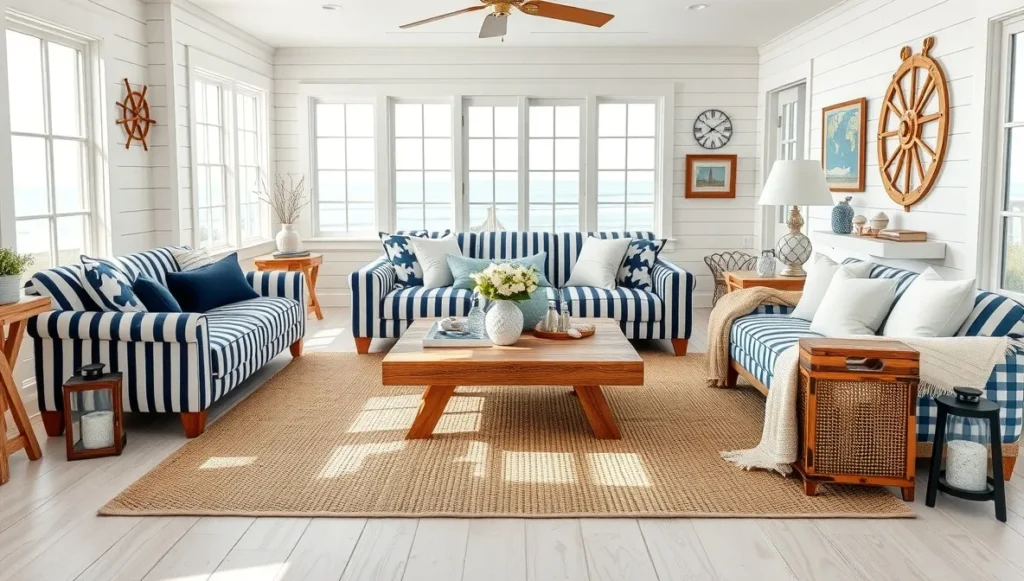- The Timeless Beauty of Portuguese Azulejo: A Designer’s Guide to Bringing Historic Charm into Modern Interiors - September 4, 2025
- Mastering Nautical Interior Design: Beyond the Obvious Anchors and Ship Wheels - September 4, 2025
- Bringing the Tropics Home: A Complete Guide to Tropical Interior Design - September 2, 2025
Table of Contents
After over 15 years of working with clients who dream of bringing the ocean’s tranquility into their homes, I’ve learned that true nautical design goes far deeper than scattered seashells and rope accents. The most successful coastal interiors I’ve created capture the feeling of being near water without looking like a themed restaurant.
Nautical vs. Coastal Design: Understanding the Key Differences
One question I hear constantly from clients is: “What’s the difference between nautical and coastal design?” While both draw inspiration from waterfront living, they create distinctly different atmospheres.
Nautical Design specifically references maritime history and seafaring culture. You gotta think yacht clubs, naval vessels, and sailing adventures. It uses crisp navy and white colors, polished brass, teak materials, and sophisticated furniture like campaign pieces and Windsor chairs.
Coastal Design captures relaxed beachside living with soft blues, sandy beiges, weathered driftwood, and casual elements like slipcovered sofas and natural textures.
Choose nautical for sophisticated, adventure-oriented spaces. Choose coastal for relaxed, casual atmospheres. Many of my best projects blend both approaches strategically.
The Foundation: Color Palettes That Actually Work
Classic Navy and White
This combination never fails, but I always add a third element to prevent monotony. Warm brass hardware, natural jute textures, or weathered wood tones create depth. In a recent project, I paired navy built-ins with crisp white walls and introduced cognac leather chairs. And, the result felt sophisticated rather than predictable.
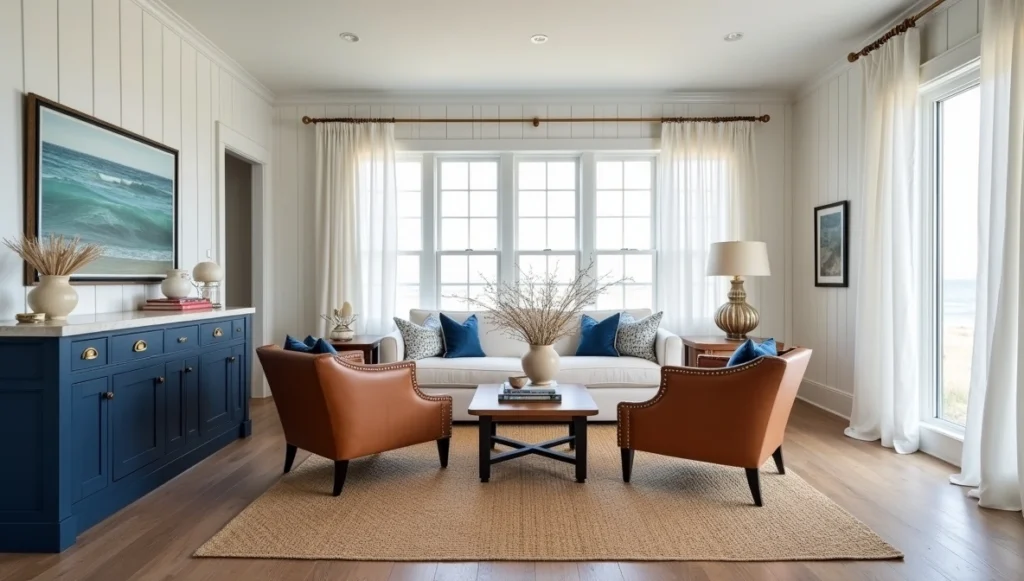
Expanded Coastal Palette
Beyond traditional blue-and-white, consider these successful combinations:
- Sage green with cream and driftwood gray
- Soft coral with sandy beige and sea glass blue
- Charcoal navy with warm white and natural linen
Here’s the sage green one I recently completed.
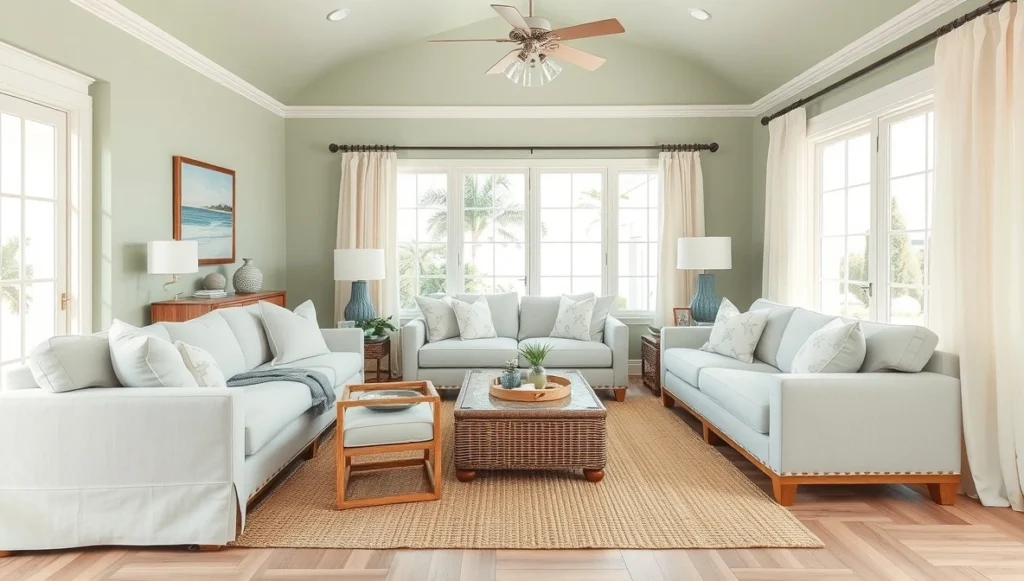
The Mistake Most People Make
Avoid using too many blues simultaneously. I’ve seen rooms that feel cold because every surface competed in different blue shades. Choose one dominant blue and balance it with neutrals and natural materials.
Materials That Capture Maritime Authenticity
Wood Selection
- Teak: Naturally weather-resistant with beautiful grain
- Reclaimed ship lap: Adds genuine maritime history
- Weathered pine: Creates sun-bleached coastal effect
- Whitewashed oak: Modern yet timeless
Here’s one such living room I came across – it features teak furniture with rich grain, a reclaimed ship-lap wall, weathered pine flooring with a sun-bleached tone, and whitewashed oak shelving and ceiling beams for contrast. Neutral linen upholstery and woven jute textures tie everything together beautifully.
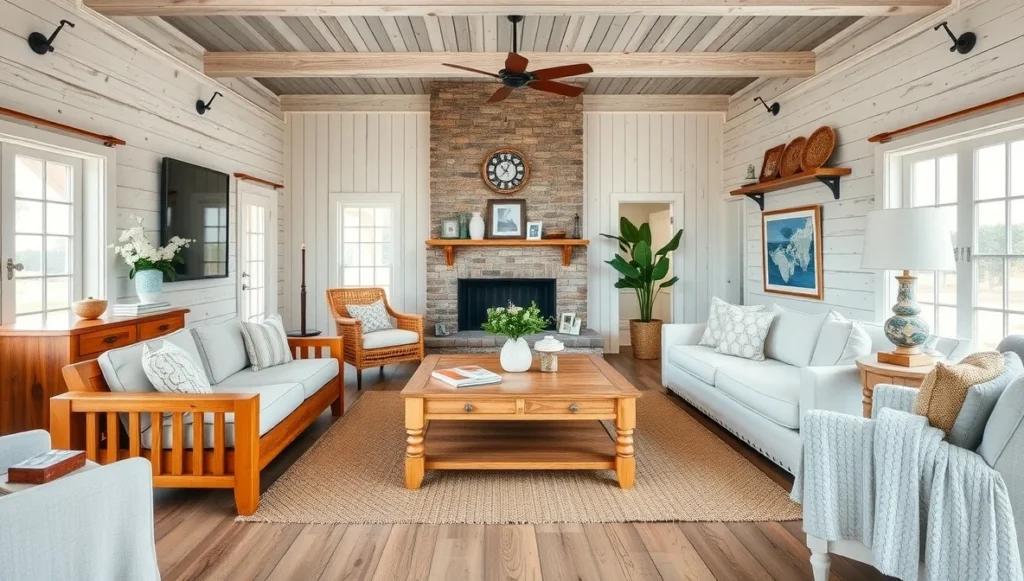
Textiles That Tell Stories
- Canvas and duck cloth for durability
- Linen in natural, undyed states
- Rope details in upholstery
- Vintage nautical flags or pictures as accent pieces (sparingly)
I visited a coastal living room that captured all those tactile details beautifully – canvas and duck cloth upholstery in neutral tones, linen curtains and cushions in their natural, undyed state, and rope details subtly woven into the furniture elements like chair arms and pillow trims. A few vintage nautical pictures on the walls added just the right touch of maritime character.
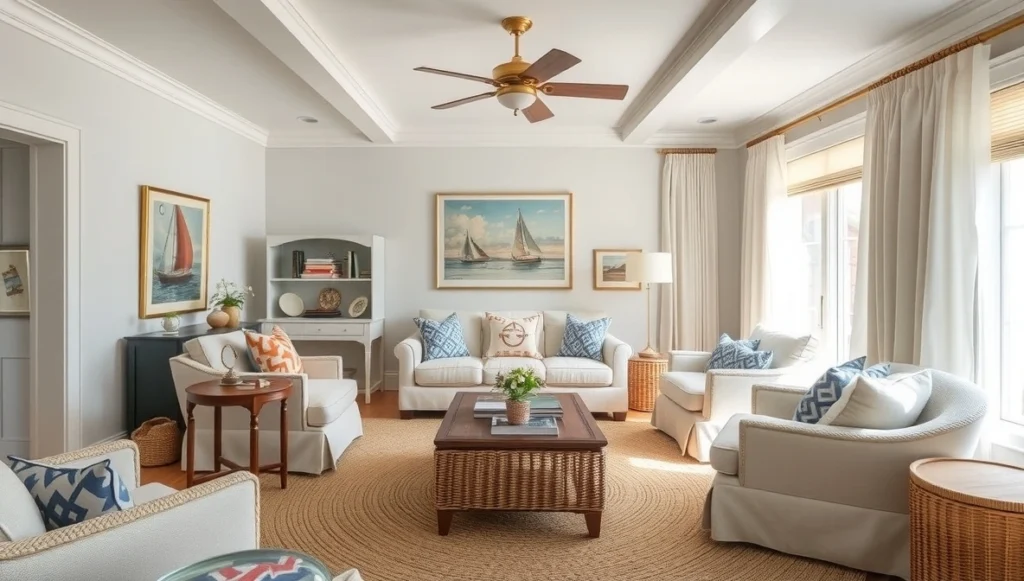
Metal Elements
Brass remains the gold standard. I source antique porthole mirrors, ship’s clocks, and brass cleats that double as coat hooks. The patina tells stories that new hardware cannot.
Furniture and Lighting Essentials
Investment Pieces Worth Considering
- Campaign furniture (originally designed for ship officers)
- Windsor chairs (spindle backs echo ship railings)
- Sea chests for functional storage
- Chart tables as desks or consoles
Lighting That Works
- Brass porthole sconces for ambient lighting
- Rope-wrapped pendant lights over islands
- Hurricane lanterns for atmosphere
- Ship’s rope chandeliers as statement pieces
Each fixture should look functional enough for actual vessel use.
Art and Accessories: What Works and What Doesn’t
What Works
- Vintage maritime charts and maps
- Black and white seascape photography
- Antique nautical instruments (sextants, compasses)
- One significant model ship per space
What to Avoid
- Plastic anchors and mass-produced coastal signs
- Too many rope elements in one room
- Artificial coral and seashells
- Cartoonish lighthouse imagery
Professional Tip: Group accessories in odd numbers with varied heights. Three brass instruments look intentional; seven scattered pieces look cluttered.
Room-by-Room Application
Living Room & Great Rooms
Focus on comfortable seating arranged for conversation—think ship’s salon. I design around substantial coffee tables that could serve as chart tables, surrounded by deep seating in weather-resistant fabrics like canvas or linen
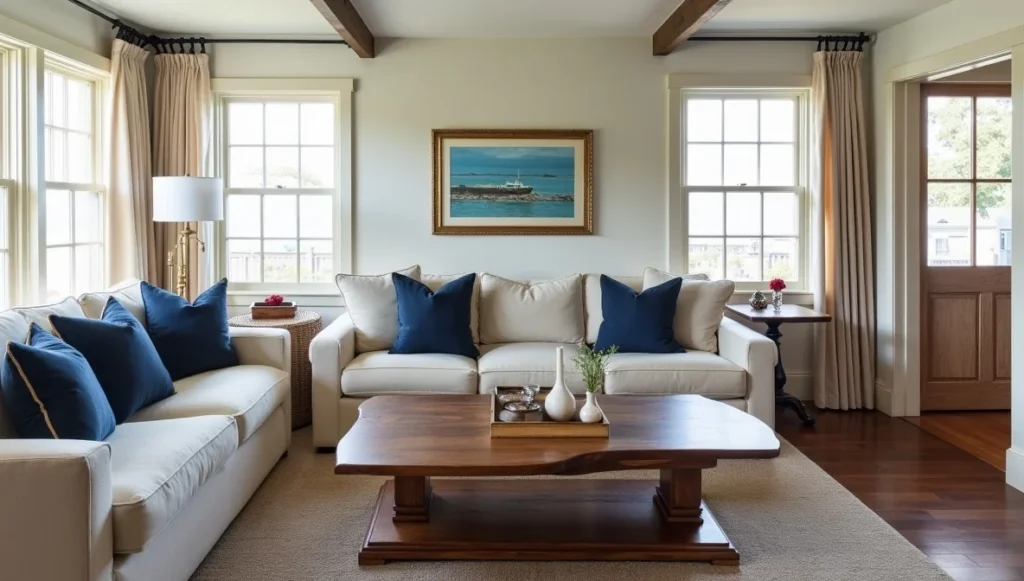
Dining Rooms
Evoke the captain’s quarters with solid wood tables featuring rope-wrapped pedestals and Windsor chairs. Built-in buffets styled like ship cabinetry work beautifully, while hurricane lanterns make perfect centerpieces
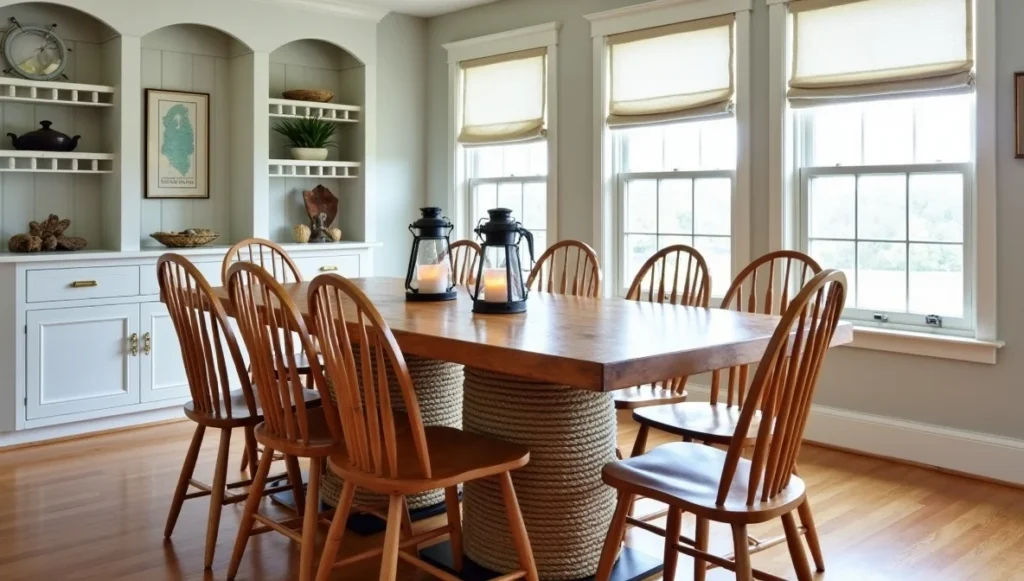
Kitchens
Ship’s galleys inspire the most functional designs
- Deep apron-front sinks like ship basins
- Open shelving with raised edges (plate rails)
- Butcher block countertops that age beautifully
- Shiplap backsplashes in crisp white
- Brass hardware throughout

Bedrooms
Think luxurious ship captain’s quarters. Built-in storage maximizes space while mimicking ship cabinetry. Tufted leather headboards suggest yacht interiors, while brass swing-arm sconces provide task lighting. Crisp white linens with navy accents work best, and vintage sea chests serve as both storage and authentic furniture.

Bathrooms
Naturally accommodate nautical themes. Teak shower floors echo yacht decks, while brass fixtures create cohesive authenticity. Ship’s ladder towel racks maximize storage, and porthole mirrors serve as perfect focal points. Navy wainscoting with white upper walls creates classic maritime schemes

Home Office/Study
Should feel like a ship captain’s chart room. Large desks positioned to command the space, built-in bookcases with brass library lights, and maritime instruments as both decoration and inspiration create the right atmosphere
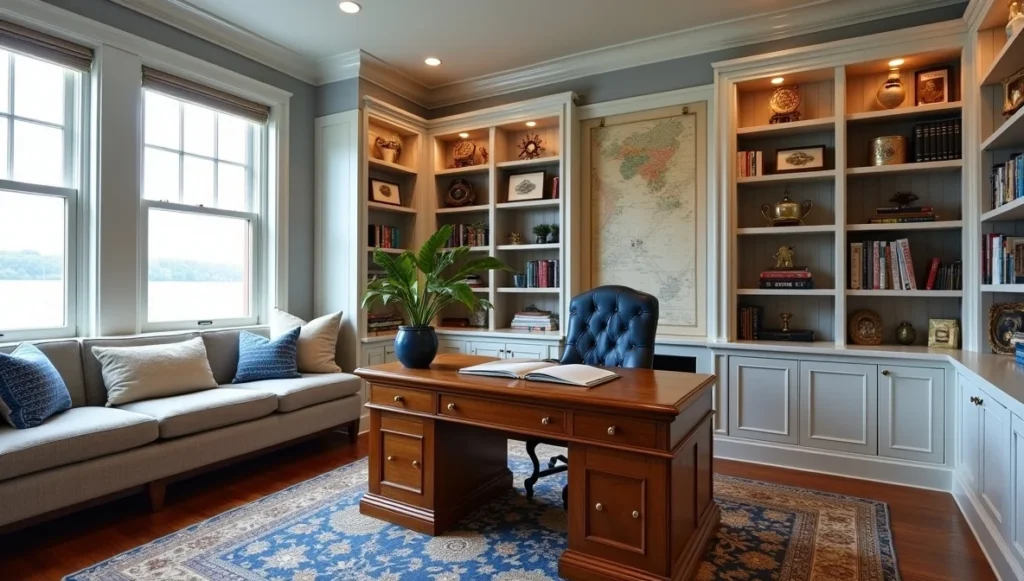
Entryway/Foyer
First impressions matter. Console tables styled like ship’s chart tables set the tone, while brass hooks on shiplap walls provide functional storage. Keep it welcoming, save dramatic statements for interior rooms
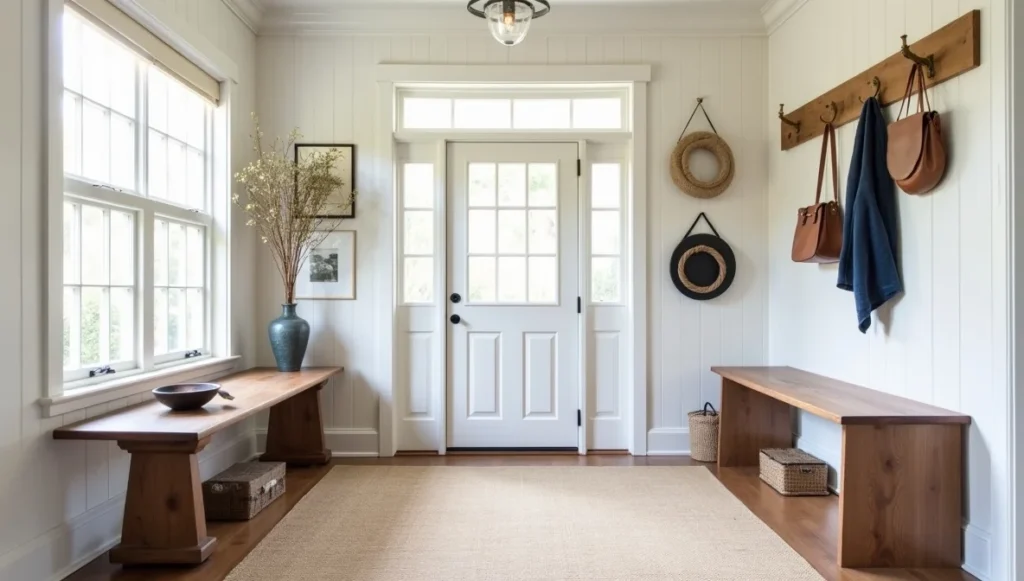
Common Mistakes I Help Clients Avoid
Overdoing the Theme
The best nautical interiors could work even without obvious maritime references. Clean lines, natural materials, and functional beauty should carry the space.
Ignoring Scale
Maritime accessories work best when substantial rather than cute. One large rope art piece makes more impact than multiple small rope accents scattered around.
Choosing Convenience Over Authenticity
The best nautical pieces take time to source. Antique shops, marine salvage yards, and estate sales yield treasures that mass retailers cannot replicate.
Budget-Friendly Approaches
You don’t need a yacht owner’s budget:
- Shop marine supply stores for functional items like cleats and rope
- Visit estate sales for vintage pieces
- DIY rope details on existing furniture
- Use paint to create ship lap wall effects
- Source vintage nautical chart prints online
Making It Work Anywhere
Living far from water doesn’t disqualify nautical design. I’ve created successful coastal interiors in desert and mountain locations by focusing on the style’s principles: simplicity, functionality, and connection to natural elements. In dry climates, emphasize cooling palette aspects. In cold regions, warm up schemes with richer woods while maintaining maritime connections.
Final Thoughts from the Design Dock
The nautical rooms that really get me excited are the ones where you feel like you’re near the ocean, but it’s not hitting you over the head with boat stuff. Start with good, solid basics like natural materials, colors that don’t fight each other, furniture that actually works. Then add the maritime touches that mean something to you.
Twenty years of doing this has convinced me that the best nautical rooms are subtle about it. The ocean should whisper, not shout.
